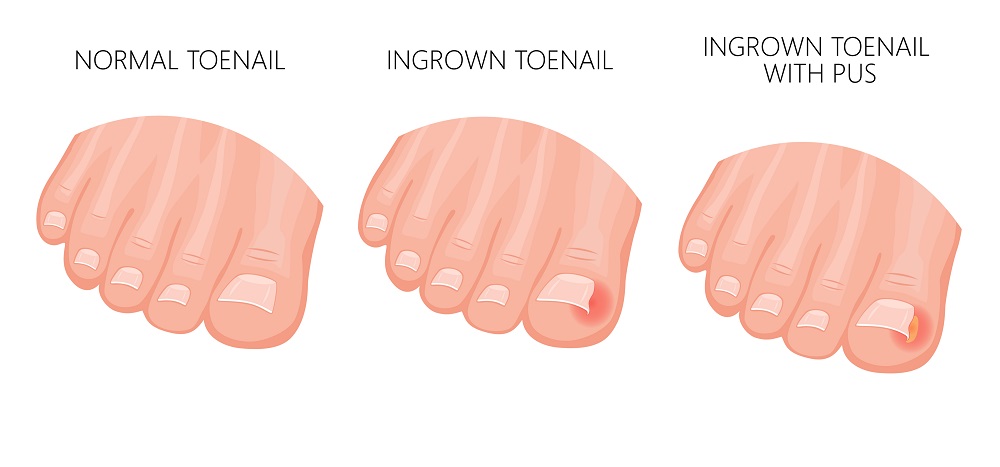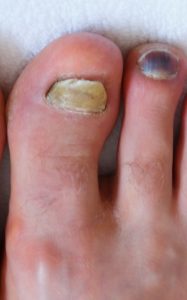What a Podiatrist Can Do For YOU!
Podiatrist Ingrown Toenail Removal [We FIX & Deal with Ingrown Toenails]
Podiatrists can perform ingrown toenail surgery! Podiatrist ingrown toenail removal is covered by most insurances or at a low cost!

Table of Contents
Services provided by our podiatrists & foot doctors:
- Toenail Fungus Treatment (Oral or Laser ).
- Toenail Trimming.
- Orthotics Fitting.
- Ingrown Toenails.
- Infected Ingrown Toenails.
- Podiatrist pedicure or medical pedicure.
- Trimming of Corns, Trimming of Calluses, and Treatment of Pressure Blisters.
- Diabetic Foot Care & Diabetic Foot Wounds.
- Athletes Foot, Dry Skin, Eczema.
- Foot & Ankle Ulcer Care.
- Infection and Abscess Care.
- Staph Infections in the Toe or Foot Treatment.
- Treatment of Plantar Warts for Your Toes and Feet.
- Foot & Ankle Injections (Steroid or Natural Solutions.)
- Management of Foot & Ankle Fractures (Walking Boots for broken toes or broken feet).
- Heel Pain (Heel Spur or Plantar Fasciitis).
- Custom Orthotics for children and adults (In the office).
- Over the Counter Orthotics for children and adults.
- Podiatrist medical pedicure.
- Extra-Depth Shoes for Patients with Diabetes.
- Diabetic Shoes.
- Gout Treatment.
- Prescription (Refills).
- Telehealth appointments.
- Shockwave therapy (AKA ESWT or EPAT therapy)
- Cold laser therapy (In the office).
- MLS laser therapy (Multi-Wave Locked System laser therapy).
- Laser for peripheral neuropathy (In-Office).
- Senior Toenail Cutting & Toenail Trimming Services.

Ingrown Toenail Questions:
Does podiatrist ingrown toenail cost?
- The cost for an ingrown toenail removal by a podiatrist is usually covered or minimal if you have insurance.
- Most major insurance plans cover ingrown toenail removal, and we take most major plans at a prime foot and ankle specialist.
- This includes Medicare, Blue Cross Blue Shield, and many other plans.
Do podiatrists deal with ingrown toenails?
- Yes, podiatrist to deal with ingrown toenails.
- We can perform permanent ingrown toenail surgery in the office.
- This procedure can be done on your first appointment and takes about 15 minutes to perform after being retracted.
- We do provide local anesthesia, which provides minimal pain for the rest of the day.
- After the anesthesia wears off, the patient is usually feeling better after having their ingrown toenail removed.
Podiatrist ingrown toenail tools:
- We use sterilized stainless steel tools with prescription medication for treatment.
- It would be difficult to use podiatrist tools inside the house because the key to ingrown toenails is diagnosing and providing anesthesia.
- We do use sterile ingrown toenail removal tools that are sterilized and autoclaved before each usage.
- Anesthesia like injectable lidocaine or bupivacaine is not readily available for injections outside of the doctor’s office.

What is the podiatrist Ingrown toenail surgery cost?
- The cost for podiatrist ingrown surgery removal is usually minimal if you have insurance plans.
- Most major insurances like Medicare Blue Cross Blue Shield do cover ingrown toenail surgery procedures.
How do podiatrists remove ingrown toenails?
- Our podiatrist and foot doctors can perform permanent ingrown toenail removal surgery on your first visit.
- If you have an ingrown toenail infection or pain, this is considered an emergency, and we recommend you call our office immediately.
- What we do is cleanse the skin with iodine or another anti-septic material.
- We then use local anesthesia to anesthetize the toe.
- This means you will have much sensation in the toe for at least about 6-8 hours.
- Once the toe has minimal sensation, we can remove the toenail and apply some medication to the corner to ensure the ingrown toenail does not return.
- At this point, we can sometimes perform a biomechanical exam to see why this ingrown toenail happens in the first place.
- In this way, podiatrists can help with ingrown toenails.
- If you have work the next day or the day after, you can usually return with less space than he did before the ingrown toenail.
- It is rare for people to take extended time off beyond a day or two, although there are never any guarantees in medicine.
Should I see a dermatologist or podiatrist for an ingrown toenail?
- We are biased, but as podiatrists and foot doctors, we see thousands and thousands of toes and ingrown toenails during our careers.
- We can perform this procedure for a low cost safely and get you back on your feet as soon as possible.
- We also make an effort to have as short of the waitlist as possible, and we prioritize getting ingrown toenails in for as soon as possible.
- If you are at home and have an ingrown toenail, we also benefit from providing home care visits.
- If you need an antibiotic, we also performed podiatrist telehealth appointments.

What are the common causes of ingrown toenails?
- If you injure your toenail
- If you wear tight, pointed shoes that crowd your toenails
- If you have unusually curved toenails
- If you cut your toenails very short and not straight across
- Engaging in activities where repeated pressure is put on toes for long periods such as ballet, soccer, football, kickboxing
What are the symptoms of an ingrown toenail?
- You may develop pain and tenderness along the sides of the toenail
- Redness around the toenail
- Swelling in the surrounding tissue (edema due to inflammation and fluid buildup)
- Signs of infection – oozing of pus, you may feel hot and shiver
Ingrown Toenail, Dermatologist or Podiatrist?
Although many doctors, including Dermatologists and family physicians, can treat an ingrown toenail, Podiatrists are the best qualified medical professionals to treat this condition. As they are foot and ankle specialty doctors, they will offer you complete foot care.
When to see a podiatrist for ingrown toenails?
You may have tried several home remedies, but the condition may not subside or may worsen with time. Then it is time to seek help. If your pain is severe and uncomfortable and the swelling and redness spread, seek help from a podiatrist. You may see pus around the toenail, which points towards infection in the surrounding tissue. You might get a fever with chills because of the ongoing infection. If you have diabetes or have problems with blood circulation, you are at a greater risk of developing complications.
Ingrown toenails can cause complications such as;
- Bone Infection – If the infection is not treated, the underlying bone can get infected too. This is especially seen in patients with diabetes because of poor blood flow and loss of sensation.
- Gangrene – If left untreated, tissue death (gangrene) can occur, resulting in amputation and loss of a toe.
Therefore, you have to take an ingrown toenail seriously. Seek help from your podiatrist early, especially if you have diabetes or any other condition which leads to poor blood flow in your feet.
How will your podiatrist deal with ingrown toenails?
Your podiatrist can diagnose an ingrown toenail clinically based on your history and symptoms. They will do a complete physical examination of your toenail and the surrounding tissue. Sometimes blood investigations such as FBC and CRP will be ordered to determine the severity of infection.
An X-Ray will be helpful to see how deep your nail has grown into the skin, especially if there is an infection. It will also reveal whether your ingrown toenail was caused by injury. The X-Ray will show if the ingrown toenail is infected and complicated with infection passing to your underlying bone.
How do Podiatrists treat ingrown toenails?
Depending on the severity, treatment options may vary.
- By lifting your toenail
If your toenail is only slightly ingrown, your podiatrist will carefully lift the edge of the ingrowing toenail and place cotton, a splint, or dental floss under it. Nail lifting is done when there is pain and redness but no pus and other features of infection. This will separate your toenail from the overlying skin while helping it to grow above the skin edge. You will be taught to replace the material daily after soaking your toes.
- Partial removal of the toenail (Partial nail avulsion)
If the ingrown toenail is more severe with pain, redness, and pus, your podiatrist will trim and remove the ingrown portion of your toenail. They will temporarily numb your toe by injecting an anesthetic so that this procedure is pain-free.
- Removal of the nail along with surrounding tissue
If you have repeated problems with your toenail, your podiatrist will remove a part of the nail, along with some underlying tissue of your nail bed. That part of the nail will not grow back following this procedure. A local anesthetic will be injected to relieve pain during the procedure.
Complete nail plate avulsion means removal of the whole ingrown toenail. It may take 3 -4 months for the nail to regrow after complete removal.
Following surgery, your toe will be bandaged. You need to keep your foot raised, rest at home for 1- 2 days, and wear special footwear to heal your toe properly. Once the bandage is removed, wear open shoes and daily soak your feet in warm saltwater.
Apart from the surgical options, a podiatrist will use LASER, chemicals, or other methods to treat ingrown toenails.
- Treatment of infection – Infection will be treated with topical antibiotics or even oral antibiotics, depending on the severity of the infection.
- Pain relief – medications will be prescribed by your podiatrist to ease your pain, such as acetaminophen (Tylenol), Ibuprofen (Advil), or Naproxen (Aleve)
Podiatrist tools for Ingrown toenails:
Toenail removal sets are comprising of all necessary tools to perform a toenail surgery. These tools are specially made of surgical-grade stainless steel to be used by professionals. This kit is called ‘Toenail Surgery pack,’ and it contains;
- Scalpel Handle #3
- Elevator
- Curette Excavator 1.5/2.0mm with Holes
- Micro-Blade Scalpel Handle
- Adson Forceps 12cm
- Mosquito Forceps 12.5cm Straight
- Mosquito Forceps 12.5cm Curved
- Cuticle Nipper Double Spring Back Lock
- Adson Brown Forceps 12cm 7:8
- Nail Splitter 12.5cm English Anvil
- Platypus Nail Pulling Forceps 14cm Standard
- Platypus Nail Pulling Forceps 14cm Narrow
- Lister Bandage Scissors 17cm
- Iris Scissors 11cm TC Curved
These products are reusable and can be sterilized.
Here are some tools considered must-have items to perform an ingrown toenail removal surgery by podiatrists.
- Nail Clippers Set – 2 Pack Stainless Steel.
- Podiatrist Toenail Clippers, Professional Thick & Ingrown Toe Nail Clippers.
- Nail and Cuticle Oil.
- 8Pcs/set Ingrown Toenail Tools Kit.
- Ingrown Toenail File and Lifters.
Podiatrist ingrown toenail cost:
Ingrown toenail treatment is typically covered by health insurance. For those without health insurance, ingrown toenail treatment with a podiatrist can be approximately $100 to $200 to take care of your ingrown toenail pain.
How can a Podiatrist fix an ingrown toenail?
After complete care of your ingrown toenail, your podiatrist will give you advice on the prevention of further recurrences;
- How to trim your nails straight across and not too short.
- Regarding lifestyle changes and home remedies – such as soaking your feet in warm water, pain relief, etc.
- Advice regarding shoes – how to select shoes that fit well and not crowd your toes.
- How to check your feet for early signs of ingrown toenails or any other foot problems.
If you cannot do this on your own, your podiatrist is always there to help when it comes to ingrown toenails or any other foot problem, from trimming your nails to complete foot care.
How does a podiatrist fix an ingrown toenail?
- Using sterilized tools and local anesthesia, we can painlessly and quickly perform an ingrown toenail procedure.
- This takes about 15 minutes in the office, and it usually feels better afterward than before the procedure after the anesthesia wears off.
- Give our office a call to find out more details. But generally, these are well-covered procedures by insurance that are safe and have excellent results.
Can a podiatrist cut out ingrown toenails without anesthesia?
- If it does not appear that anesthesia is needed, sometimes we can cut out the toenail without having to utilize anesthesia.
This can result in excellent pain relief with minimal effort or cost.
Should I see no GP or podiatrist for an ingrown toenail?
- We are biased as podiatrists, but we believe we can provide excellent ingrown toenail removal surgery care.
- We are trained in the latest techniques and the best local anesthesia to provide painless treatment.
- In this way, we can take great care of your ingrown toenail. We also provide home care appointments and tell health appointments for those who need them.
When to go to a podiatrist for an ingrown toenail?
- If you are reading this and worried about your ingrown toenail, it is never too early to see a podiatrist.
- We make emergency appointments to get you in as quickly as possible, and this procedure takes 15 minutes.
- If you have an eligible insurance plan, we take most insurance plans, which is a very cost-effective treatment.
- If you are in Michigan, call us soon for an appointment!
How do podiatrists treat ingrown toenails?
Podiatrists can perform different treatment options for your ingrown toenail.
- 1) This means that the ingrown toenail can be trimmed.
- 2) It means the local anesthetic can also be used similar to a dentist numbing a tooth prior to a procedure, at this point the toenail can be resected back and treated permanently.
- 3) A third option also exists which means a permanent ingrown toenail removal surgery can be performed.
Balance Foot & Ankle, Howell, Michigan
Balance Foot & Ankle, Bloomfield Hills, Michigan
Balance Home Care & Wound Care
11 Reasons To Choose US!
- 🥇 We work hard for YOUR Satisfaction. (If you’re not 100% satisfied with your appointment, we WILL do everything we can to FIX IT for you.) Terms & Conditions.
- 🦶The BEST Podiatrists: Board Certified in Foot Surgery & Board Certified in Podiatric Medicine for all of your foot & ankle needs!
- 💻Telehealth appointment from the comfort of your own home!
- 🚗 You Can Park 100% for Free Right Outside The Door.
- 📲 You Can Book Online 24/7 Right From Your Phone.
- 🌙 You Can Get A Late Appointment Or Seen Outside of Regular Hours……No Need To Take Time Off Work.
- 🏠 If you cannot come to see us due to health issues or immobility… We can come to see YOU!
- 💉 The BEST Tools: In-office X-ray, In-office fluoroscopy, In-office ultrasound, injections, skin treatment, and in-office surgical suite. We are trained to use the NEWEST equipment.
- 📞 You Can Take Up Our Offer for a Phone or Telehealth Consult With Our Podiatry Team before you arrive if you are unsure if we can help you.
- 🏥 A professional cutting edge surgical suite staffed by residency trained Board Certified Foot & Ankle Surgeons: Minimally Invasive Surgery!
- 👣You Get Treated By Podiatrists Who Specialize In the Foot & Ankle, So They KNOW What’s Needed To Get You Back On Your Feet.
Google Rating
Prime Foot & Ankle Specialists - Podiatrists & Foot Doctors
4.9 341 reviews
-
Alex Hyman
★★★★★
3 months ago
Just watched a youtube video on "Cuboid Syndrome Treatment" by Michigan Foot Doctors and I think the suggested … More treatment in the video has almost instantly healed my foot!
-
Doug Gosa
★★★★★
5 months ago
Amazingly thorough! Astoundingly effective results! If you’re in their area - they need to be your people!!!
-
Joseph Russo
★★★★★
a year ago
I'm 54 years old, and I'm always enlighten by the info I get from this channel. We can never stop learning to better … More our health.
Free BOOK to solve foot pain:
STOP wasting TIME & MONEY on your foot & ankle pain!
“11 SIMPLE Ways to STOP Foot PAIN. “
Learn 11 simple step-by-step tips to get rid of foot & ankle pain… even if you’ve suffered for months or years and your doctor told you nothing could be done to help!

Frustrated With Your Foot Pain? Let Us Help!
Not sure what to do?
Not sure who to ask?
- If you live in Michigan, we can HELP!
Fill in the form, and one of our highly qualified team will be in touch to discuss your specific problem.
What a Podiatrist Can Do For YOU!
Best podiatrist near me ingrown toenail removal:
We service most major cities in the metro Detroit and southeast Michigan region. These areas include Oakland county, Macomb county, Warren county, Livingston county and Washtenaw county.
Areas we service:
The podiatrists & foot doctors of Prime Foot & Ankle Specialists are available for in office visits, home care and telehealth for the following locations:
- Berkley Michigan
- Oakland County Michigan
- Royal Oak Michigan
- Oak Park Michigan
- Huntington Woods Michigan
- Clawson Michigan
- Ferndale Michigan
- Birmingham Michigan
- Madison Heights Michigan
- Franklin Michigan
- Hazel Park Michigan
- Southfield Michigan
- Troy Michigan
- Bloomfield Hills Michigan
- Lathrup Village Michigan
- Novi Michigan Area
- Bloomfield Michigan Area
- West Bloomfield Michigan Area
- South Lyon Michigan Area
- Northville Michigan Area
- But anyone in the state of Michigan.
Contact us if you need to be seen in Michigan or Oakland County Michigan!
Ingrown toenail gp or podiatrist office pictures:
In office surgeries podiatrists can perform:
We can perform toenail, toe, foot, heel & ankle surgery in the office!
We can help with:
- Minimally invasive foot surgery.
- Minimally invasive bunion surgery.
- Minimally invasive hammertoe surgery.
- Corn and callus removal surgery.
- Plantar wart removal surgery.
- In-office permanent ingrown toenail removal surgery.
- Removal of unwanted spurs, bumps, or lumps on your feet.
- Shockwave therapy (AKA ESWT therapy or EPAT therapy)
- Cold laser therapy.
- MLS laser therapy (Multi-Wave Locked System laser therapy).
- Laser for peripheral neuropathy.
- 3D custom orthotic scan.
Frequently Asked Podiatrist Questions?
Q: What is a podiatrist?
A: Podiatrists are Doctors of Podiatric Medicine, DPM. Podiatrists are podiatric physicians, foot doctors, or podiatric surgeons. Podiatrists often diagnose and treat the foot, ankle, and other related structures of the leg.
Podiatrists receive similar training that other doctors complete. They complete four years of training in a podiatric medical school and three years of hospital residency training.
The podiatrists at Prime Foot & Ankle Specialists have received extra training, such as fellowships beyond residency and board certifications by the board of foot and ankle surgery and the board of podiatric medicine.
Q: Do podiatrists accept insurance?
Yes, podiatrists do, except for insurance. We set most major insurance plans as podiatrists and foot doctors. This includes Medicare, Medicare plus blue, Blue Cross Blue Shield, United Health, and Aetna health. Humana, Blue Care Network, Oscar Health, Molina, Meridian, Health Alliance Plan of Michigan (HAP), Health Share Plans, Christian Health Share Plans, Worker’s Compensation Plans, and Cigna Healthcare.
Q: Is podiatrist toenail trimming covered by insurance?
Yes, this service may be covered for people with help issues that cannot help themselves. If your foot is in pain or has a health issue, a podiatrist is recommended to evaluate you, and this is a covered option.
If you have foot pain, please call our office and schedule a no-obligation consultation with our podiatrists to assess your eligibility for foot care.
Q: Does insurance cover podiatrist ingrown toenail removals?
Yes, ingrown toenails are covered by insurance. Let us help! Don’t wait to come in if you have a toe or foot infection.
Q: What parts of the body do podiatrists treat?
A: Podiatrists in Michigan are licensed to treat the foot, ankle, and lower leg below the knee.
At Prime Foot & Ankle Specialists, we specialize in toenail problems, toe problems, foot problems, heel problems, ankle problems, minimally invasive surgery, advanced diagnostic techniques, and advanced treatment options. We pride ourselves on being your choice for all foot and ankle problems!
Q: When should I call a podiatrist for an appointment?
A: Pain is never normal, especially if it lasts longer than a week. This means that most insurance plans will cover a visit if you feel you have a problem developing with your feet.
The longer you wait, the more serious the pain may become, leading to hospitalization or further foot problems.
It would help to have it evaluated and treated to avoid long-term problems.
Q: Can podiatrists perform corn removal and callus removal?
A: Corns and calluses are thick, hardened layers of skin. Development of corn and callouses occur when your skin tries to protect itself against friction and pressure.
If corns and calluses are causing you discomfort, you should seek treatment. The most common areas of development are on your feet and toes. We provide treatment for these somewhat unsightly painful conditions. Don’t hesitate to contact us today.
Q: Does insurance cover the podiatrist treatment of corns and calluses:
If you feel you have a foot problem that you cannot care about on your own, evaluation and diagnosis are covered. We provide a no-obligation consultation to inform you if this is the case. In general, foot pain and a painful lesion on the foot covered the visit.
Q: What is a hammertoe?
A: A Hammertoe is a contracture (bending) of one or both joints of the second, third, fourth, or fifth toes.
We provide advanced imaging such as ultrasound and digital X-rays to diagnose immediately in the office.
This abnormal bending can pressure the toe when wearing shoes, causing painful problems.
Conservative and surgical treatment options are available for the treatment of Hammertoes.
Q: What causes heel pain?
A: Typically, heel pain is not caused by one single incident or injury, and the most common cause is plantar fasciitis, which can lead to long-term pain that may one day require surgical treatment if not corrected.
Repetitive stress/pounding of the heel can cause heel pain.
Other common causes can include inflammation of the plantar fascia, inflammation of the back of the heel, inflammation of the heel pad, progressive degeneration of the Achilles tendon, or a stress fracture caused by repetitive stress to the heel.
Q: What are orthotics or insoles?
A: Orthotics or insoles are custom foot supports that replace the over-the-counter supports that come in shoes you buy off the shelf at the store. These are designed to hug your foot more efficiently than over-the-counter products to significantly aid in balancing the biomechanical inadequacies of your feet and legs.
Q: How can you tell if you have an infected ingrown toenail?
A: You may have an infected ingrown toenail if there are any signs of redness, swelling, pain, and drainage, such as puss coming from the area.
- If you notice any of these symptoms, contact your podiatric Physician immediately.
- If you have toenail pain, this may also be a sign. It is never normal to have toenail pain.
- If you have toenail redness or swelling, this is never normal.
Q: What is plantar fasciitis that causes heel pain?
A: The plantar fascia is the thick connective tissue on the bottom of the foot.
- This tissue connects the heel bone to the toes and is responsible for creating the arch in your foot.
- Plantar fasciitis is inflammation of the plantar fascia.
Q: Does Medicare pay for diabetic shoes and custom orthotics?
A: Medicare will cover diabetic shoes and inserts for some patients.
- Patients must meet and have specific qualifying conditions verified by the Physician managing their diabetes.
- If you have diabetes, you should have an annual foot evaluation performed by a foot doctor or podiatrist to determine your eligibility for this benefit through Medicare and other insurance carriers.


